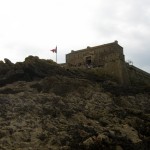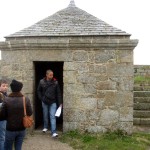The walled-in City of Saint-Malo sits on the northern coast of Brittany, overlooking dozens of rocky islands which sit stoicly on the horizon, unmoved by the English Channel rushing around them. The air of the city is mixed with the waters that crash endlessly on these rocks. These same waters, which now hang in the mists on the breeze, are the same which have ever greeted those who sail from Saint-Malo, off to adventure. It was here that fellow Gustavus student Joey Taylor and I spent our Spring Break. And what a wonderful adventure it was.
Encrusted on many of the islands that can be seen from the city’s noble walls are the fortresses which added to the defense of Saint-Malo. These defenses date from around the time Jack Sparrow would have been sailing in another part of the world—if not for the prickly detail that Johnny Depp is stuck existing in the present. But the corsairs in Saint-Malo’s history were not created by script writers or heavy eye-liner, because Saint-Malo is the very really pirate capital of France.
I shouldn’t actually use pirate and corsair so interchangeably, because the pirates of Saint-Malo were employed by the king of France, making them slightly more like a navy than pirates, but also slightly more piraty than a navy, hence, corsairs. These corsairs did everything they could to cause trouble for France’s enemies: raiding, pillaging, stealing cargo, and sometimes directing large quantities of flying silverware at them with canons.
Such was the trouble caused by Saint-Malo’s inhabitants that the King of England once tried to blow the city up with an explosive ship. However, it seems that they only built it for exploding and not for aiming, because it completely missed its target. Instead of blowing up Saint-Malo, it blew up a nearby bit of the English Channel, which probably bubbled some, and didn’t really care in the end. The only victim in the whole city was a cat. So, they sent the cat directly to the king of England, which probably made him about as happy as someone who is very angry.
After touring the forts, it really isn’t surprising that it took until World War II for someone to successfully breach the city’s defenses. With so many rocky islands from which to pick, they were able to place the forts quite strategically, making it very hard to get to the city if you’re flying the wrong flag. Not only were the locations of the forts impressive, but the design of the buildings themselves.
The two that Joey and I visited both had passive water filtration systems, and passive air ventilation in their powder rooms. For the first system, water would collect when it rained, and pass through ingeniously designed compartments filled with advanced technologies like sand of varying fineness. The clean water collected at the bottom of an artificial well, but it didn’t sit stagnant there. Whenever it rained (all the time) the water would continue to refresh.
In the powder room you apparently also want to avoid stagnation, but there it’s a question of airflow, not water. So, clever geometry which I didn’t really understand is used to create channels connecting the inside of the powder rooms to the outdoors. These let air flow through, but kept out rain, light, and carelessly flicked cigarette butts (which was probably the greatest danger, assuming modern France is any indication). In addition, to prevent their source of lighting from doing what the king of England couldn’t, the powder rooms were lit from the outside using mirrors. This way, no torches or lanterns were needed in there.
I know what you’re thinking: “Ingenious, really, how many ways Muggles have found of getting along without magic.” But honestly, seeing the incredibly creative technologies created by people long ago is often a reminder that we aren’t any smarter than they were. We just have more dead smart people who figured things out and left us books explaining it all. The technologies in which we take so much pride today are not our creations: they are the collaborative effort of almost everyone who has ever thought about anything. Yet, sometimes I think the technology we have now gets in the way of our ingenuity: we don’t go to the effort of designing buildings that ventilate themselves, because we can just plug something in to do all that. Now, as we come to realized the very high price of running everything on electricity, I think we will be looking back more and more to the ingenious ideas I saw in these forts.
- This my friends, is a pirate ship.
- The captains desk in the Pirate Ship.
- We were lucky we got to see the captain while she was out on deck.
- Le Petit Bé, one of the forts we visited.
- Here’s a guy coming out of the powder room (and apparently he didn’t like it very much down there).




